Contents
- What Is Japandi Design?
- History of Japandi Style
- Elements of Japandi Design
- How Japanese and Scandinavian Styles Complement Each Other
- Decorating in Japandi Style
- Japandi Style Kitchen
- Japandi Style Living Room
- Japandi Style Bathroom
- Japandi Style Bedroom
- Japandi Style Office
- Conclusion
While life often seems chaotic, the Japandi style offers fresh air—an oasis of calm in which two seemingly distant cultures merge harmoniously. Imagine the minimalism of Japanese interiors intertwined with the cozy simplicity of Scandinavian design. "Japanese style is not just a design trend; it is a lifestyle," says renowned interior designer Shanti Vijaya.
The Japandi style can be called an interior style as a lifestyle, a philosophy that values simplicity and ergonomics. With its practicality and functionality, the Japandi style is a confident choice to create a visually pleasing and relaxing home. Read on to discover how to bring this practical, timeless style into your space.
Our online catalog features a wide selection of high-quality and durable Japandi-style interior doors by Belldinni.
What Is Japandi Design?
Japanese design is an organic fusion of two timeless design philosophies—Scandinavian functionality and Japanese minimalism. Although these styles originated on opposite ends of the globe, they both value simplicity, rationality, and a connection to the natural. The result is an interior style emphasizing clean lines, neutral palettes, and organic materials.
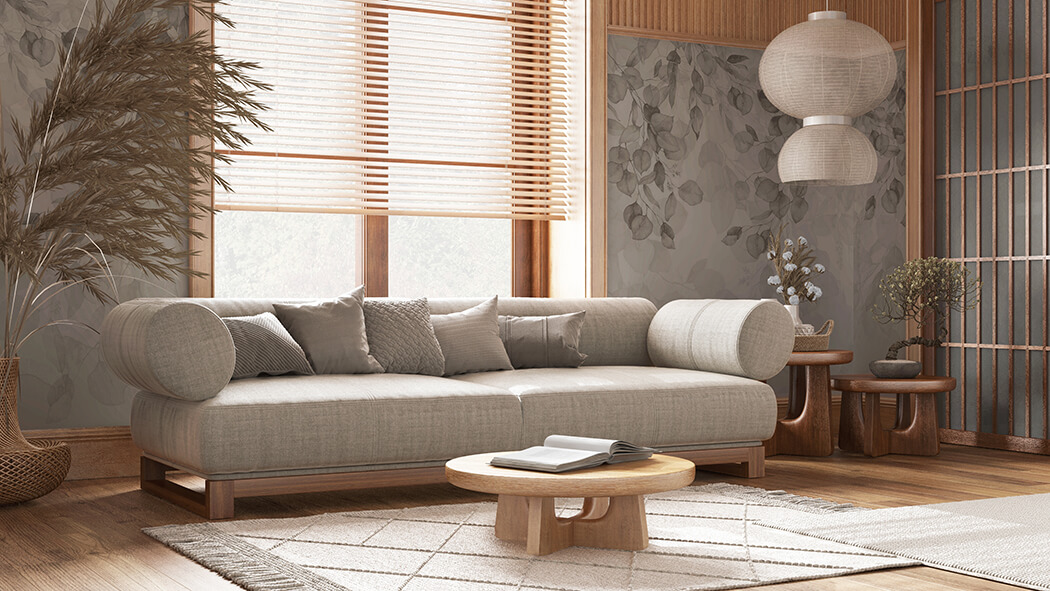
Japandi is based on the Japanese concept of wabi-sabi, which finds beauty in imperfection, and the Scandinavian hygge ethic, which emphasizes coziness, comfort, and a balanced lifestyle.
The most important components of this style are natural materials such as wood, stone, and linen. The color palette is soft and neutral, including whites, taupe, and grays, accented by rich dark tones of wood or stone. Plenty of natural light is also a key feature, filling the room with tranquility.
Celebrities, too, have fallen in love with the timeless aesthetic of the versatile Japanese style. Celebrities like Gwyneth Paltrow and Marie Kondo have been known to incorporate elements of Japanese style into their homes. Paltrow's California home showcases a minimalist Japanese influence combined with cozy Scandinavian-inspired textures, while Kondo's home perfectly illustrates her love of orderly, efficient use of space.
History of Japandi Style
The origins of Japanese style stretch back more than a century, bridging two distant cultures with a shared philosophy of simplicity, craftsmanship, and a deep connection to nature. The story began in the mid-19th century when Japan opened its borders after more than 200 years of isolation under the Sakoku policy. As Japanese art, furniture, and design began to penetrate the West, Scandinavian designers, known for their minimalism and inspiration from nature, found themselves permanently enamored with the Japanese aesthetic.
In the late 19th and early 20th centuries, Scandinavian designers and artists began to visit Japan. Many saw strong parallels between the Japanese principles of wabi-sabi, which finds beauty in imperfection, and their philosophy of hygge, which emphasizes warmth and comfort in simplicity. Of course, this led to a mix of styles.
Japandi's timeless style continues to evolve, instilling in homeowners the values of minimalism, ergonomics, and an emphasis on natural materials.
Elements of Japandi Design
Neutral Color Palette with Contrast
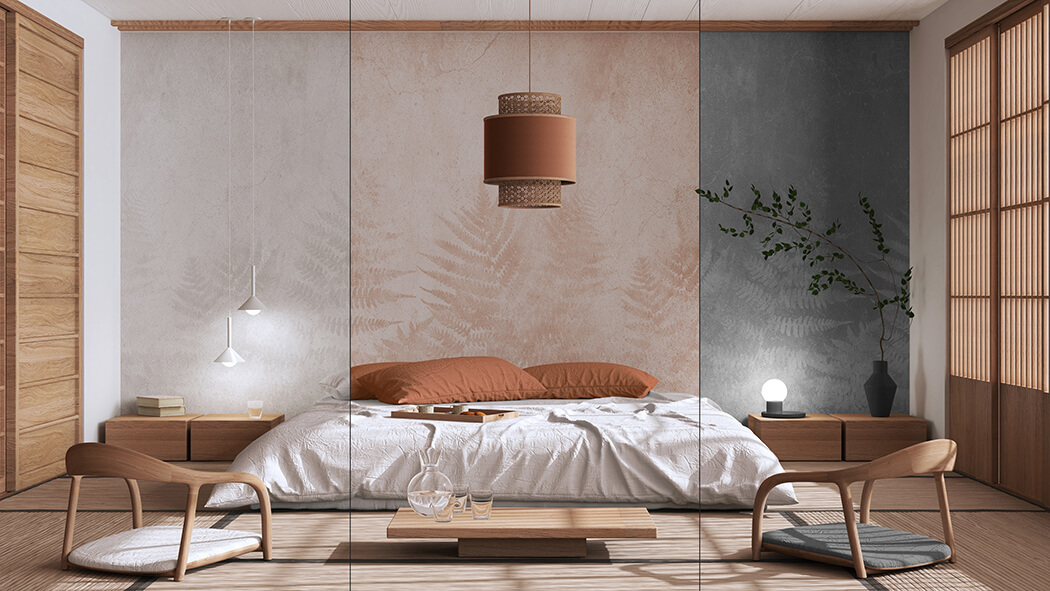
Japandi-style interiors favor neutral tones but with more contrast than traditional Scandinavian designs. Soft beige, cream, and light gray are combined with deeper tones such as charcoal, forest green, and dark wood. The best solution for doorways is wooden interior doors decorated with multiple panels, 3D milling, or clear or frosted glass inserts, which additionally fill the room with natural light.
Natural Materials and Organic Textures
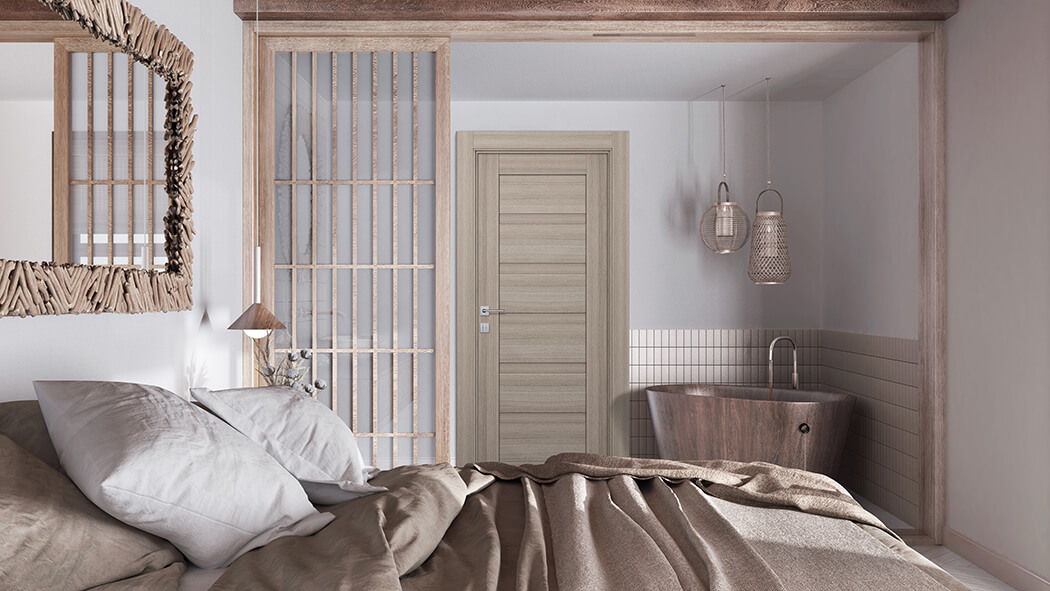
Interior Door Model: Louver Shambor
Wood, stone, linen, and rattan dominate Japandi interiors. Interior doors, often crafted from natural woods like oak or walnut, echo this aesthetic. Sliding doors inspired by Japanese shoji screens offer both style and functionality. They save space in the room and are also very easy to use, so even small children and elderly family members will have no trouble getting around the apartment or house.
Minimalist, Functional Furniture and Doors
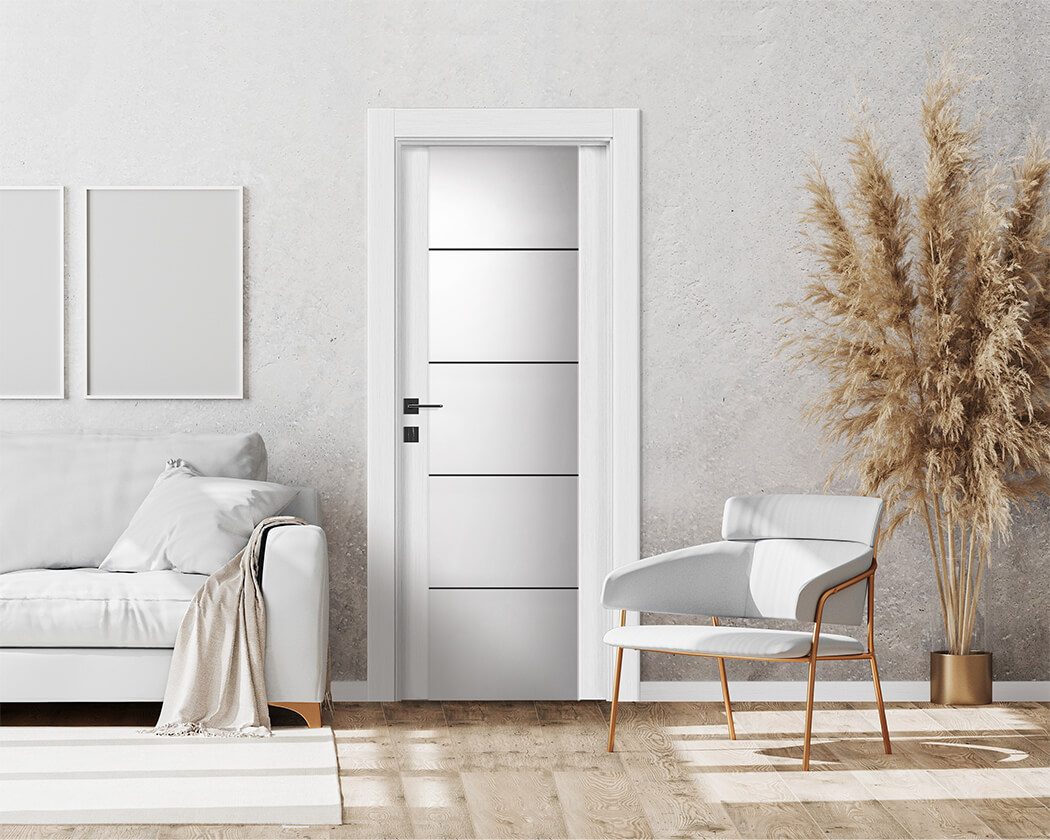
Interior Door Model: Smart Pro H3g 4H Black Strips Vetro Polar White
In Japandi spaces, furniture and doors are simple and practical, and the homeowners don't skimp on them. After all, quality furnishings are the best investment in your comfort. They are durable and will serve you for years to come.
Emphasis on Craftsmanship
Japandi homes value handcrafted products. However, remember that "less is better than too much" applies here. This phrase means it is best not to clutter the space with art but to leave more air and freedom.
Connection to Nature
Natural light is an integral part of Japandi's design. Choosing a light fixture is not easy either, but if you can live in a house with large windows, it's perfect! As mentioned earlier, glazed interior doors, including patio doors, also look amazing in living spaces.
Thoughtful spaces with minimalism
Japandi spaces are characterized by minimalism and thoughtfulness. Every centimeter has its purpose, and every interior object is essential.
How Japanese and Scandinavian Styles Complement Each Other
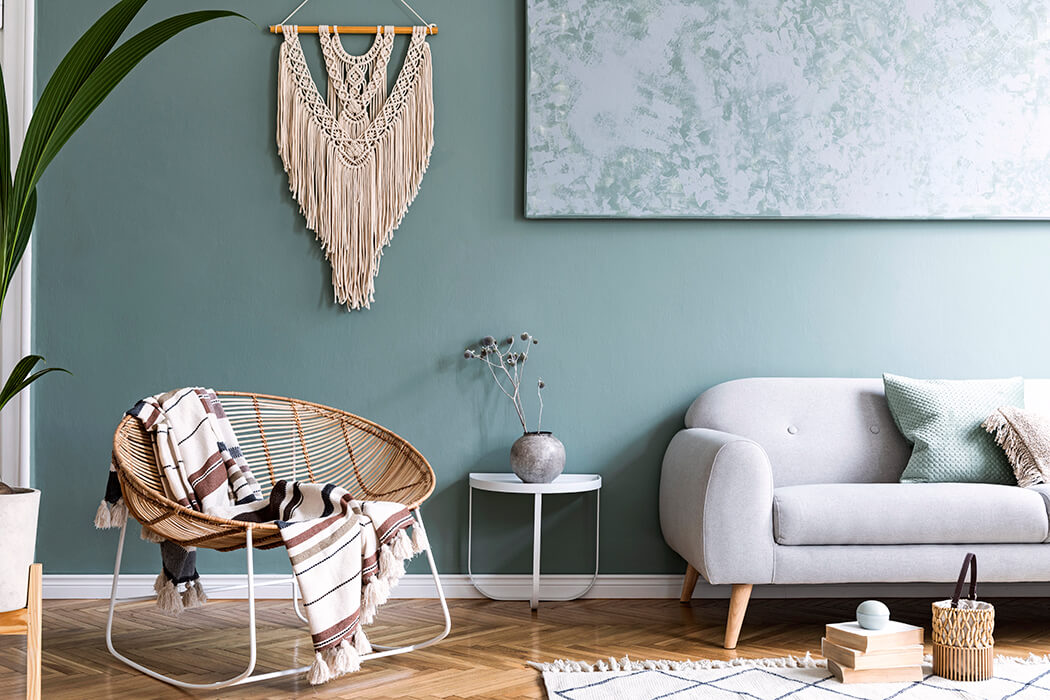
Initially, Japan and Scandinavia may seem like diametrically opposed universes, though don't be surprised that despite the geographical distance, their design philosophies have a deep, harmonious connection. The seamless blending of these two styles into what we now call Japanese is no accident. They came together by embracing mutual values: minimalism, functionality, and a love of nature.
Another common feature of these styles is the use of natural materials. Scandinavian design often uses light-colored woods such as birch and pine, while Japanese interiors favor darker woods such as cedar and walnut. Similarly with textiles, soft fabrics such as wool can easily coexist with cotton and silk.
Ultimately, the beauty of the Japanese style is how these two different aesthetically pleasing styles complement each other.
Decorating in Japandi Style
-
Natural materials: Get a small wooden coffee table or a wicker basket. Their texture will bring a touch of nature into the interior and become a bright detail.
-
Create order: Let your living space breathe by keeping it as uncluttered as possible. Use ergonomic storage solutions, such as boxes.
-
Functional furniture: Choose high-quality, stylish, and practical pieces that won't need replacing after 2-3 years of use. Invest in your family's comfort.
-
Muted color palette: Stick to whites, beiges, and grays, adding darker tones for contrast.
-
Texture with soft fabrics: Opt for an unusual rug, especially in a child's room, to liven up the interior. It does not necessarily have to be a bright shade; its non-trivial shape or pile is enough.
-
Natural light: Let the sunshine fill each room with light. Use semi-transparent curtains.
-
Celebrate imperfections: Embrace the beauty of handmade objects, from uneven ceramics to raw wood furniture.
Japandi Style Kitchen
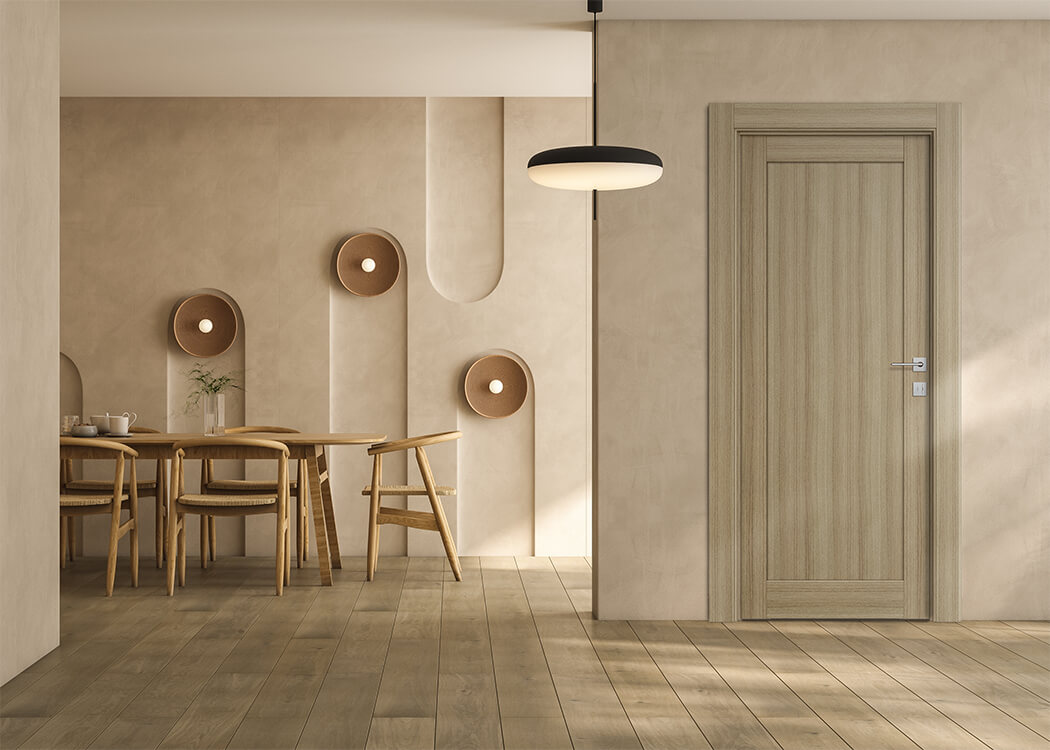
Interior Door Model: Shaker 1 Panel Shambor
You've ever heard it said that the kitchen is called the heart of the home, right? It's where the whole family gathers for Sunday breakfast or dinner after work, where people discuss how the day went and plans for tomorrow. In general, the kitchen is not only a place where food is prepared but also an important room where it should be as cozy as possible. For its design, choose neutral colors such as cream, beige, muted green, or gray, accented with darker shades such as black or walnut. For cabinets and countertops, go with unfinished or lightly stained wood.
Light-colored tiles can be used as flooring, and minimalist light fixtures will support the sleek aesthetic. Provide hidden storage, and for a touch of personality, use simple and functional decor such as handmade ceramics or a small collection of potted plants.
Japandi Style Living Room
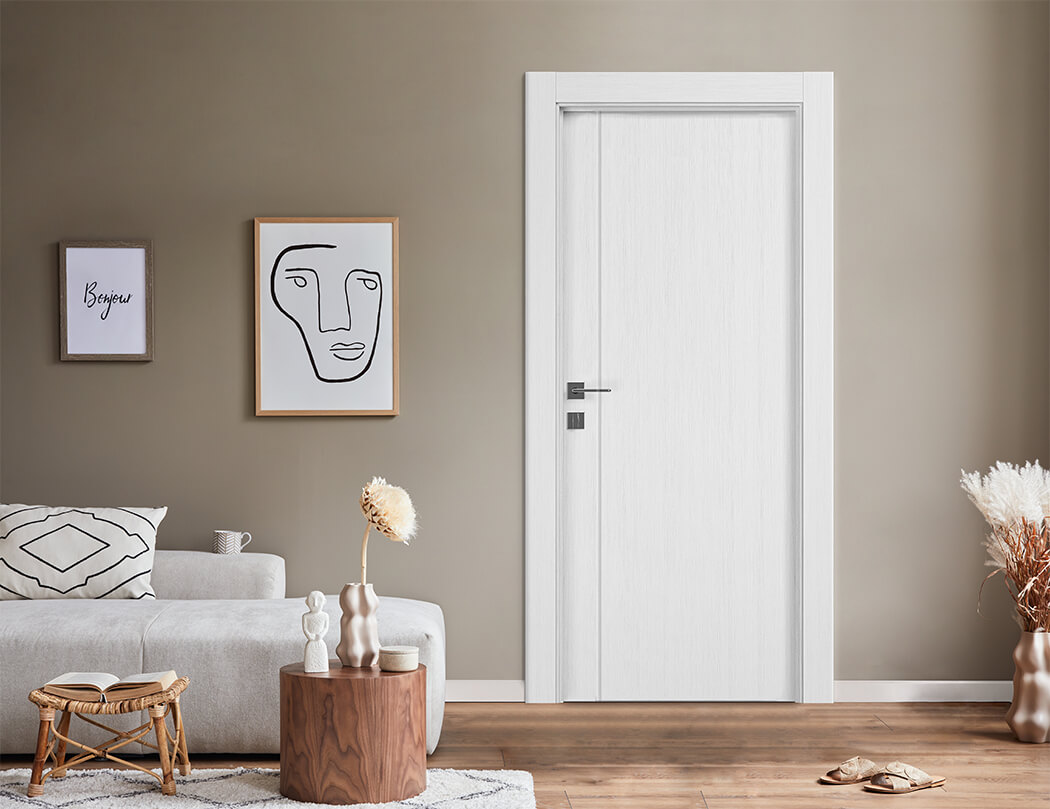
Again, the Japanese style does not tolerate experiments with shades, so the pastel palette will look the best and be the most practical. Minimalistic high-quality furniture, such as a wooden coffee table, a streamlined sofa, or a cozy armchair, is essential. For upholstery, choose natural, environmentally friendly fabrics such as linen or cotton, as well as wool blankets or soft rugs that will add warmth.
Add a few well-chosen decorative items such as a handmade vase, bonsai tree, or abstract artwork to give the interior character without cluttering it. Natural light is crucial for Japandi living rooms, so make the most of it by installing large windows without partitions. As for interior doors, we recommend exploring the range of glazed models and non-standard configurations: sliding, pocket, and hidden systems (invisible doors that you can design in your way, for example, wallpapered, painted in the color of the walls or decorated with decorative plaster).
Japandi Style Bathroom
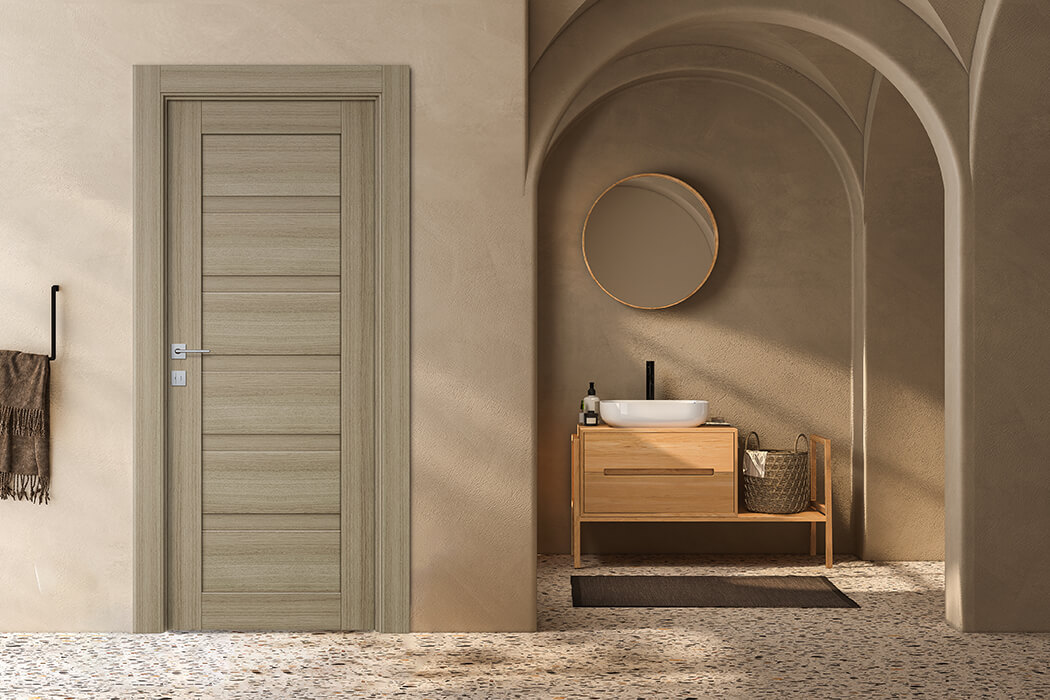
Interior Door Model: Orleo Shambor
The bathroom is the perfect place to embody the Zen style of Japanese design. Choose a neutral monochrome palette using natural materials. A freestanding stone sink combined with minimalistic matt-black steel faucets adds a touch of elegance to the room while maintaining simplicity.
For the flooring, tiles made of natural stone or light wood can create a serene base, and elements such as bamboo racks or rattan baskets will stand out for their texture. Place a few candles or a simple wooden bath tray for a secluded atmosphere to enhance relaxation.
Japandi Style Bedroom
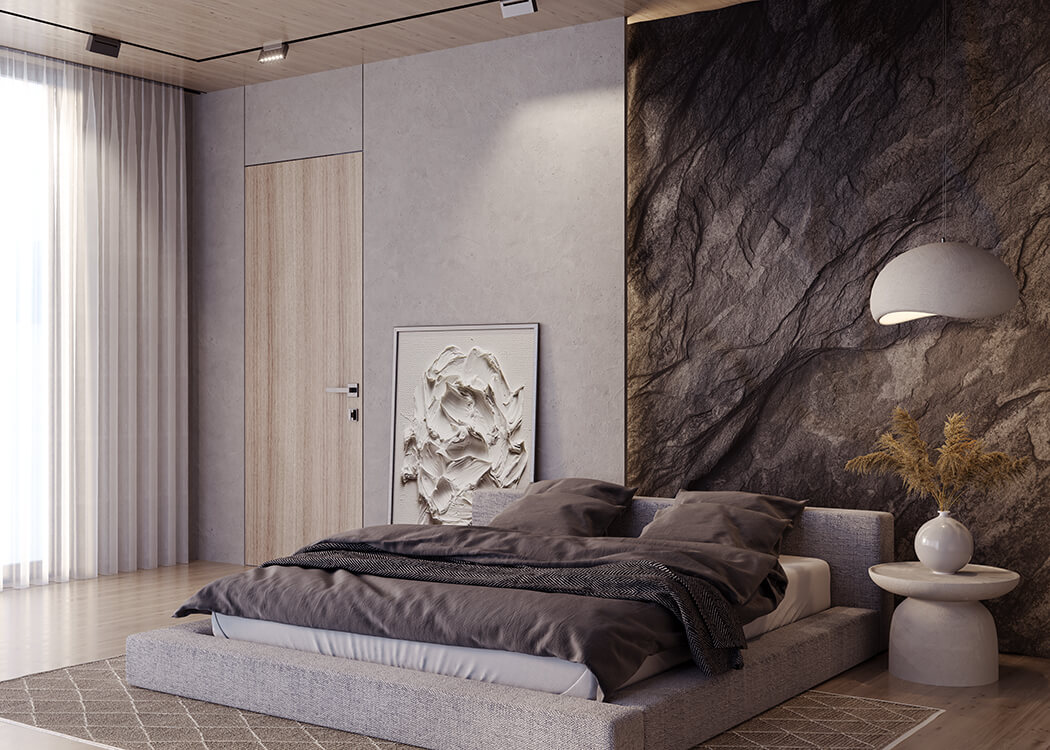
Interior Door Model: Optima Shambor Frameless
The bedroom should always have calm vibes so that you can really relax and unwind. A good combination would be light colors and a deep green shade. Choose low-profile wooden furniture with clean lines, such as a platform bed or bedside tables, and natural materials, such as linen or cotton, that are suitable for bed linen, as always.
Use minimalistic decor like simple framed prints, small plants, or ceramic vases. For comfort, consider multi-layered curtains and traditional swing doors with Solid Core filler, which will provide sound insulation.
Japandi Style Office
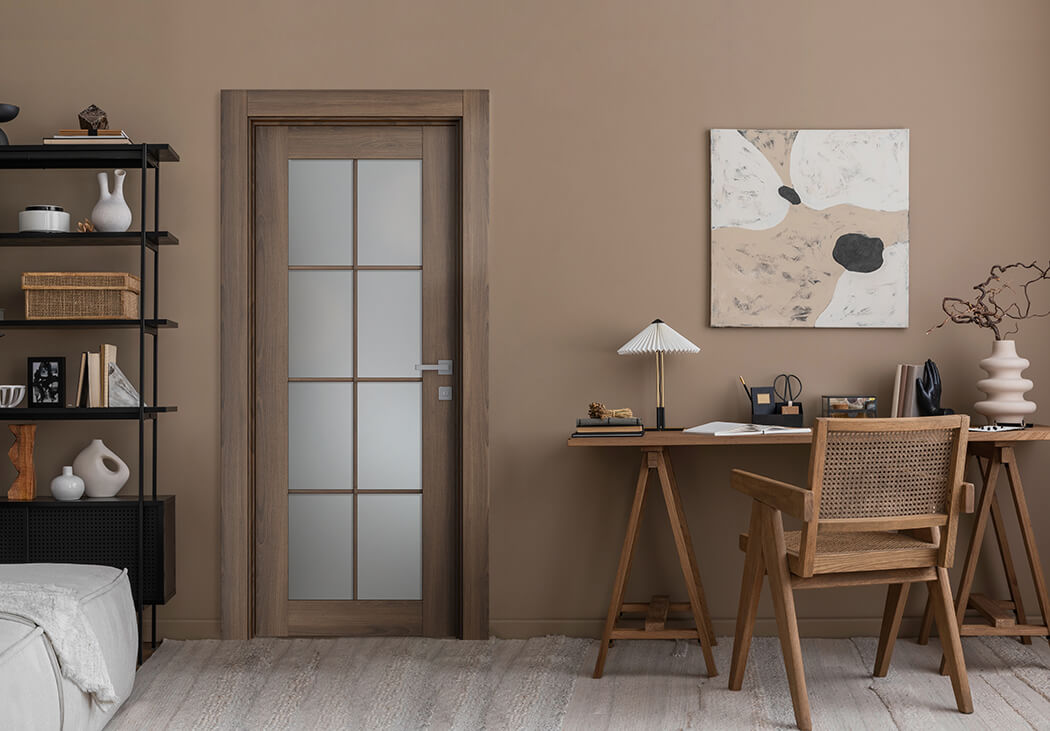
Interior Door Model: Avon 8 Lite Vetro Pecan Nutwood
The same recommendations that are described for other rooms are relevant for the office: calm shades, natural, high-quality pieces of furniture, a minimum of decor, and maximum light. However, due to the utmost importance of a quiet environment, give preference to swing doors. The slab fits snugly against the door frame in its closed position, protecting you from unnecessary sounds.
Conclusion
Japandi style celebrates simplicity, craftsmanship, and a connection to nature. Blending the best Scandinavian and Japanese design offers a peaceful, balanced approach to interior spaces. As you bring Japandi into your home, remember to choose each element with intention, creating a functional and serene space.

